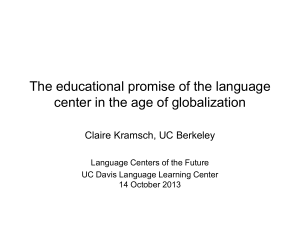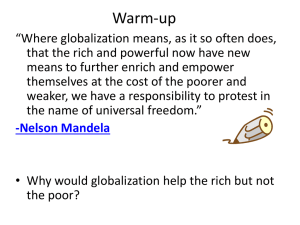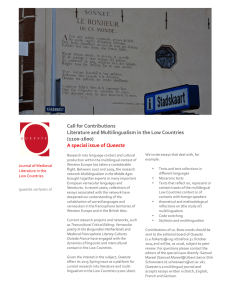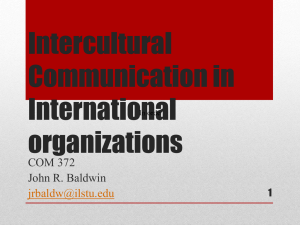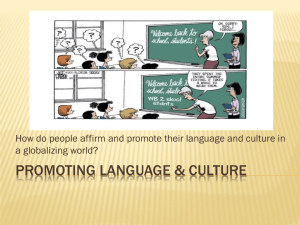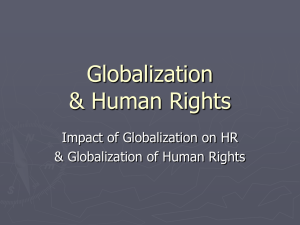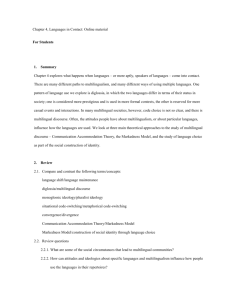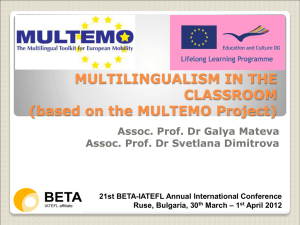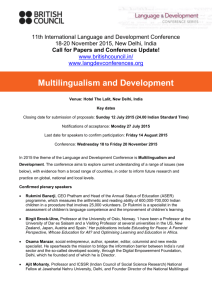here - The Consortium for Language Teaching and Learning
advertisement
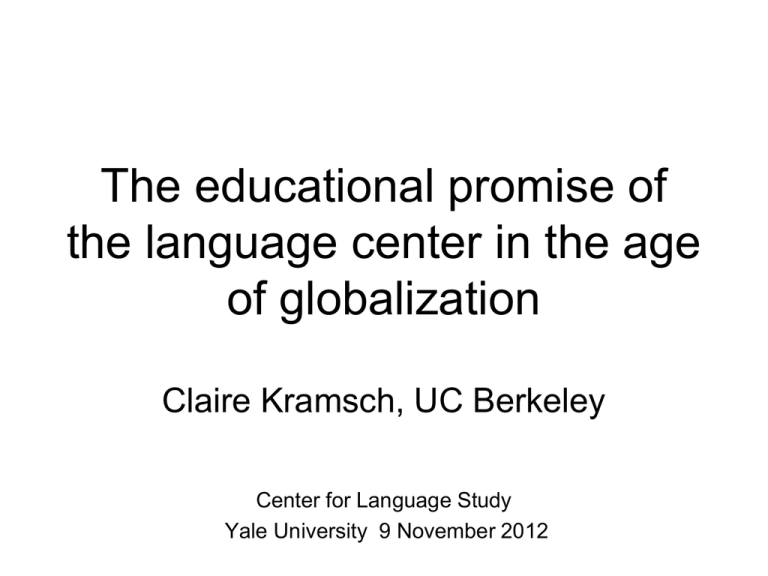
The educational promise of the language center in the age of globalization Claire Kramsch, UC Berkeley Center for Language Study Yale University 9 November 2012 Outline Introduction: Historical background • Samples from language centers’ mission statements • The challenge of globalization in FL education • Back to basics: what is language, language teaching, language learning? • New possible roles for the language center Conclusion: The global/local language center Introduction: Historical background • The legacy of the language lab: opportunities and constraints. Great opportunities for exploring instructional technology and CmC. But risk of ghettoization of language teaching and reductionist view of IT. • Support for disenfranchised language faculty and professional development. But professional development is not the same as intellectual stimulation. • Space for pedagogic and technological innovation and experimentation. But learning conditions have changed radically. Who is asking the difficult questions brought on by globalization? • Needed: A space for conceptualizing the fundamental epistemological and disciplinary restructuring necessary to meet the demands of meaning making, communication and literacy both in FLs and in English in a global age. Samples from language centers’ mission statements STANFORD At the Language Center, we prepare all Stanford students to have a foreign language capability that enhances their academic program and enables them to live, work, study, and research in a different country. Stanford students need to be able to initiate interactions with persons from other cultures but also to engage with them on issues of mutual concern. In order to accomplish this goal for Stanford students, the Language Center is proficiency-oriented and standards-based. A proficiency orientation refers to emphasizing doing rather than knowing. We try to make sure that students learn to speak, listen, read, and write in ways that are immediately useful in a real world setting. Standards-based refers to the National Standards on Foreign Language Learning that attend not only to linguistic dimensions, but also to connections that learners make between languages, cultures, and various academic areas; comparisons between languages and cultures; and a knowledge of communities that speak a particular language. UC BERKELEY Founded in 1994, the Berkeley Language Center’s mission is to support the learning and teaching of heritage and foreign languages on the Berkeley campus and, where appropriate, in the University of California system. To meet this overarching goal, the BLC employs numerous strategies to improve teaching effectiveness and enhance the learning environment: → Provide language instructors with opportunities to learn of new developments in the fields of sociolinguistics, language pedagogy, and second language acquisition theory; → Support research by language instructors and its dissemination at professional meetings and in professional journals; → Support faculty production of new language learning materials; → Provide faculty and students with state-of-the-art learning facilities and equipment; → Provide faculty and students with access to language learning materials; → Maintain a library and media archive of materials for language teaching and research. RICE UNIVERSITY’s Center for the Study of Languages (CSL) seeks to develop and promote excellent language teaching and learning for twelve languages through the third year of instruction with new technologies and the current national standards for foreign language education playing an integral part of the syllabus. The principal objective of our programs is to educate students who are linguistically and culturally equipped to communicate successfully. U OF WISCONSIN-MADISON The administrative home of the Doctoral Program in Second Language Acqusition (SLA), the Language Institute spearheads collaborative projects and instructional initiatives including: -research studies on foreign language education such as the 2009-13 study, funded by the U.S. Department of Education International Research and Studies Program, to investigate the alignment of postsecondary student goals with the goals of the U.S. Standards for Foreign Language Learning, and a study, with International Academic Programs, to research the long-term impact of study abroad; -course and curriculum development initiatives such as distance, online language courses, including hybrid Chinese courses for high school students, online Chinese courses for business professionals, instructional materials development in languages such as Kazakh, Russian, Persian, Swahili and Uzbek; -outreach programs such as World Languages Day for Wisconsin K-12 schools and the broader community; -workshops and invited lectures such as the 2012-13 series on Language, Cognition and Sociality and bi-weekly Language Over Lunch brownbag presentations; -the Russian Flagship Center, an undergraduate program that provides opportunities for highly-motivated students of all majors to achieve a professional level of competence in Russian by graduation; -acacemic and career advising for undergraduate students and resources for university academic advisors. CERCLL U. of Arizona Center for Educational Resources in Culture, Language and Literacy (CERCLL) is a Title VI Language Resource Center. We research culture, language and literacy within less commonly taught languages. We also provide educators with teaching resources and opportunities for meaningful professional development. YALE Center for Language Study The CLS is a place for the language community to share ideas, bridge cultures, and further the study of languages at Yale. The CLS is offering a new Certificate in Second Language Acquisition designed for Yale graduate students in departments of language & literature to provide a comprehensive training program in SLA and language teaching methodology. BROWN UNIVERSITY Center for Language Studies. Since 1987, the Center for Language Studies has facilitated contacts and cooperation among faculty with teaching and research interests in second languages. Our mission is to strengthen language study at Brown University through promoting research, developing teaching techniques, courses, programs, and learning resources, and creating new curricular configurations. CLS supports the application of technologies in language learning, promotes the professional development of language faculty and graduate students. Members include teaching faculty from every language department on campus. CLS is the academic home for American Sign Language, Arabic, Catalan, English for International Teaching Assistants, Hindi/Urdu, and Modern Persian. In addition, the Center often offers non-credit language courses. For academic year 2012-13 we will be offering non-credit courses in Kiswahili and Turkish. In sum: Some of the traditional roles of the language center have been: • • • • • • provider of teaching services (Stanford, Brown) testing services (Stanford) delivering instruction (Brown, Stanford, Rice) in-service training of teachers (Brown, Stanford, Berkeley) producing innovative pedagogic materials (U of AZ, Brown) research and resource clearinghouse (Berkeley, UW Madison, U of AZ) Language Centers have been called upon to promote, improve, professionalize language learning & teaching, commonly conceived - the how. They have not played a role in reconceptualizing the why and what for of foreign language instruction, the internationalization of American education, or the increasingly multilingual nature of research and education in a global world. The challenge of globalization IT TAKES A WORLD VIEW TO CREATE A GLOBAL CITIZEN Avenues: The World School is now open. And students at every level (K-9) are gaining the benefits of our World Course, developed at Harvard by leading educators. With a curriculum that integrates demography, geography, economic trade, world cultures and more, we’re preparing students to seize opportunities in this interconnected world. Every Avenues student will graduate with fluency in a second language. To help them achieve this, we’ve integrated “best practices” from some of the world’s most innovative schools. In our lower school Mandarin Chinese immersion program, for example, students gain a deeper understanding through experience. Their music class is taught in Mandarin. And they learn musical rhythm through body movement, based on a technique developed in Switzerland. If you’d like to learn more about Avenues admissions, you’re invited to attend a parent information event. Register at avenues.org or call Avenues admissions at 646.664.0800. Avenues. The World School. 259 Tenth Avenue New York. The challenge of globalization for FL education Globalization: • Mobility and migration of people, capital, goods and knowledge Block, D, Gray J. & Holborow M. 2012.Neoliberalism and Applied Linguistics. R. Duchene,A. & Heller,M.(Eds) 2012 Language in Late Capitalism. Pride and profit. R. • Global information technologies, 24/7 media, ubiquity and simultaneity Coupland, N (Ed.). 2010 Handbook of Language and Globalization. Wiley-Blackwell. Block, D. 2010. Globalization and Language Teaching. Ibidem 287-304. Block D & Cameron, D. (Eds.) 2002. Globalization and Language Teaching. Routledge. Increased diversity and rapid change, i.e., pragmatic unpredictability, semiotic uncertainty, authentic inauthenticity Kramsch, C. 2012. Imposture: A late modern notion in post-structuralist SLA research. Applied Linguistics 33:5 Kramsch, C. In press. Authenticity and legitimacy in multilingual SLA. Journal of Critical Multilingualism Studies. Kramsch, C. In press. History and memory in the development of intercultural competence. In F.Sharifian & Jarmani (Eds.) Language and Intercultural Communication in the New Era. Routledge. • Cultural hybridity, linguistic multiplicity, explosion of speech genres -Briggs, C. & Bauman, R. 1992. Genre, intertextuality and social power. Journal of Linguistic Anthropology 2:2, 131-172. -Ward, Steven. 2012. Neoliberalism and the global restructuring of knowledge and education. Routledge • New ways of talking about language, about culture. From language as usevalue to language as exchange-value. - Heller, M. 2003. Globalization, the new economy, and the commodification of language and identity. Journal of Sociolinguistics 7:4, 473-92. - Heller, M. and Duchene, A. Pride and profit: Changing discourses of language, capital and nation-state. In Duchene, A. & Heller, M. Language in Late Capitalism. Routledge - Thurlow, C. & Jaworski, A. 2010. Tourism Discourse. Language and global mobility. Palgrave Macmillan. Proliferation of meaning making practices, hypersemioticization of everyday life The new skills required: • cognitive, social, cultural, emotional, aesthetic flexibility, • expectation of diversity and difference, • multiplicity of voices, • tolerance of ambiguity, • awareness of one’s own subject position, • sense of history, • questioning dominant ideologies The challenges: lack of teacher preparation; expectations of students; language ideology in the public at large; lack of consensus on what language is and what language does Back to Basics Globalization prompts us to ask new questions about the ultimate goals of language instruction in an era of multilingualism, heteroglossia etc. Language learners have to learn, as the 2007 MLA Report advocates, how to “operate between languages” (p.35), i.e., how to develop a linguistic and cultural competence across multilingual contexts. While this multilingual imperative has been the theme of a special issue of the MLJ on multilingualism (Jasone Cenoz and Durk Gorter 2011), and while applied linguists have put forth a range of suggestions for embracing multilingualism (from Auer and Wei’s plurilingualism to Blommaert’s truncated multilingualism, to Makoni and Pennycook’s disinventing national languages, to post colonial scholars heterolingualism, and Creese & Blackledge’s notion of translanguaging), such multilingualism has not yet been taken seriously by foreign language teachers in departments of foreign languages and literatures at educational institutions. See MIIS School of trsl./interpretation predicated on perfect monolingualism A and B (no Spanglish or Chinglish!) . “What is language? language teaching?” FL instructors at UC Berkeley discover that they have quite different views of what they are in the business of doing. Urdu: “Language, basically/fundamentally, is a means/medium of communication through words and sentences. Language teaching is to try to enable learner to communicate through words, sentences and paragraphs in target language and to understand what is spoken or written through words, sentences and paragraphs”. Chinese: “Language is medium and message, form and content. It encapsulates the values, beliefs, past and present histories of a community sharing the same set of symbols.” “Language is a cultural product, a systems of forms that people in a community with shared cultural behavior, values, and mind utilize or manipulate to express ideas and feelings to fulfill particular purposes in particular sociocultural contexts” German: “Language is what we live, speak, read, see, hear, feel, taste, play with, wonder about. Yes, it is a tool to communicate, but so much more – it lets us express emotions, feelings, thoughts, upbringings, cultures, worldviews. Language helps us to see and understand the world we live in, its people, and ourselves.” Language teaching is to make learners curious and enable them to change perspective, learn about others and themselves, become tolerant of ambiguity, appreciate the aesthetics of a language and get a sense about what language represents and can do.” Italian: “In terms of its social attribute, language is what makes us different from other species, what makes us human beings. We use it to describe the world that we live in, to express our emotions and deliver our thoughts. Language also helps us get a better understanding of other cultures and people. Overall, language is a lively and changing subject.” Danish: “A code consisting of symbols/elements. Different codes connected with different (often nation states) groups, used to communicate. Symbols imbued with meanings beyond the symbolic value. Learning a language is learning to crack the code.” French: “Language is not only a closed linguistic system made up of linguistic structures and parts of speech, it is also a living mode of communication and a way of constructing social and cultural realities, real and imagined worlds, and historical and social identities”. FL teachers in the U.S. don’t seem to have had to grapple yet with issues of global English, multilingual encounters, historical identities, and the neoliberal commodification of language. Nor have they really dealt critically with the injunction of the MLA Report (2007): “Students are educated to function as informed and capable interlocutors with educated native speakers in the target language. They learn to comprehend speakers of the target language as members of foreign societies and to grasp themselves as Americans – that is, as members of a society that is foreign to others. They also learn to relate to fellow members of their own society who speak languages other than English.” All the phrases in italics raise questions five years later. New possible roles for the Language Center REDEFINE THE LANGUAGE CENTER: - In addition to being an L2 Pedagogic Center where L2 skills are researched and taught , and FL teachers are trained, the Language Center should be - a Language Research Center for the exploration of how knowledge gets constructed through different symbolic systems, among which L1, L2, L3. TOPICS FOR RESEARCH - What knowledge/language ideology gets constructed through our foreign language pedagogies through our textbooks and other instructional materials - What is at stake in the construction, transmission and dissemination of knowledge through meaning-making symbolic systems and practices of inquiry that are different in different societies/cultures ? How is knowledge constructed in English different from knowledge constructed in French or German? For the sciences and engineering, see: Baumgratz, G. Mobility in higher education: Cross-cultural communication issues. European Journal of Education 28:3, (1993) 327-228. • • • • • Initiate both undergraduate/ graduate students and faculty to the field of applied linguistics, broadly conceived. Find links between the humanities and the social sciences, the social sciences and the hard sciences (see Big Ideas courses), foreign languages and English through focus on “Big L Language” in the construction of knowledge: see St.Olaf Help familiarize undergraduates, graduate students and faculty with the big questions raised by globalization: the bilingual mind, multilingualism, (in)authenticity, code-switching, language ideology, the economy of symbolic systems; old and new ways of “learning”. If faculty and grad students don’t want to tackle these big questions, engage the undergraduates. They are hungry for this kind of knowledge ! Help redefine “internationalization” as reframing the questions, not diversifying the answers : see St.Olaf, Waterloo U., Indiana U. The Language Center A forum for discussing the role of Language in a global economy Who, if not the Language Centers, can ask the difficult questions of the future: FROM STUDENTS - Is global English an aid or a threat to foreign language study? (see J.House languages for communication vs. languages for identification in ”ELF: a threat to multilingualism?” Journal of Sociolinguistics 7:4 (2003), 556-578) - “I already know Spanish, why do I need to take Russian?” (see M.Holquist’s big L argument) - “I just want to know enough German to talk to graffiti artists in Germany; why do I need the whole of German grammar?” (see S.B.Heath’s argument) - “How do I get to better my English?” (an American learner of German) FROM TEACHERS - “While it seems reasonable to downplay the educated NS as the goal of instruction, what will take its place as the goal of instruction with regard to language performance measures?” - “If we are to teach how to ‘operate between languages’, are we no longer to worry about control over such linguistic features as verbal aspect, mood, question formation, word order, pragmatic knowledge etc.?” - “In a post-national era, what should we mean by ‘culture’? (a purely social/anthropological category? A psychological category? A humanistic category?) and how does culture interface with language?” - “What is the appropriate ‘knowledge base’ for a foreign language educator?” All these questions capture the anxiety of foreign language learners and teachers faced with the spread of English and its attendant global ideologies. L2 grammars = the last bastion of incorruptibility ? Foreign languages have a crucial role to play in the discussion about the globalization of education. What but the Language Center can play that role? Conclusion: The global/local Language Center Equally distant from a totalizing tourist gaze on foreign languages and cultures (taught in standard L2), and from a totalizing view of Language with a big L (taught in English), each foreign language presents a unique case study in local particularity, starting with its unique grammar right up to its unique history and literature. The Language Center must make sure it remains both universal in its relevance and particular in its approach. Its patron saint? Saint Jerome. Jerome In Durer’s engraving you sit hunched over your desk, writing, with an extraneous halo around your head. You have everything you need: a mind at ease with itself, and the generous sunlight on pen, page, ink, the few chairs, the vellum-bound books, the skull on the windowsill that keeps you honest (memento mori). What you are concerned with in your subtle craft is not simply the life of language–to take those boulderlike nouns of the Hebrew text, those torrential verbs, into your ear and remake them in the hic-haec-hoc of your time– but an innermost truth. For years you listened when the Spirit was the faintest breeze, not even the breath of a sound. And wondered how the word of God could be clasped between the covers of a book. Now, by the latticed window, absorbed in your work, the word becomes flesh, becomes sunlight and leaf mold, the smell of fresh bread from the bakery down the lane, the rumble of an oxcart, the unconscious ritual of a young woman combing her hair, the bray of a mule, an infant crying: the whole vibrant life of Bethlehem, outside your door. None of it is an intrusion. you are sitting in the magic circle of yourself. In a corner, the small watchdog is curled up, dreaming, and beside it, on the threshold, the lion dozes, with half-closed eyes. —Stephen Mitchell. Engraving above by Albrecht Durer. We can imagine the language center of the future as operating between the global Language of knowledge and the local languages on the ground: - Between the “life of language” and its L2, L3 “innermost truths” - Between the “spirit of language” and the “covers of our textbooks” - Between the multilingual “vibrant life” of bakers, butchers and crying babies and the “magic circle” of our classrooms. - Between languages, dialects, registers, styles, voices, modalities. A language center that would help teachers navigate both the mandate to “operate between languages” and the need to operate within their very distinct grammars.
